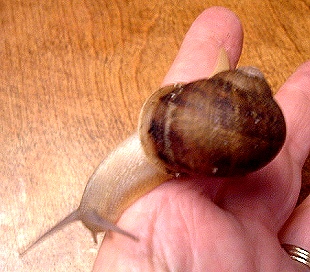|
|
|
| |
|
Latin Name & Author
(person who described the species)
|
Helix aspersa (Müller,
1774)
|
|
Common name:
|
brown garden snail,
European brown snail,
France: escargot petit-gris or Chagrine'
Italy: Zigrinata or Maruzza
Spain: caracolas
|
|
Synonymous Names:
|
Helix aspersa,
Cantareus aspersus, Cryptomphalus aspersus, Cornu aspersum
|
|
Classification:
|
Kingdom Animalia:
Animal, animals, animaux
Phylum Mollusca: molluscs, mollusks, mollusques, molusco
Class: Gastropoda Cuvier, 1797 -- caracol, caramujo, escargots, gastéropodes,
gastropods, lesma, limaces, slugs, snails
Subclass
Heterobranchia
Subclass:
Pulmonata
(Freshwater Pulmonate
Gastropods)
Order: Stylommatophora
(terrestrial snails and slugs)
Suborder: Sigmurethra
Superfamily Orthalicacea
Superfamily Orthalicacea
Family: Helicoidea
Genus: Helicidae Linnaeus, 1758
Species aspersum Muller, 1774
|
|
Species Origin:
|
Europe
|
|
Odessa's Origin:
|
Greece
|
|
Distribution Today:
|
- Asia:
- Turkey
- borders
of the Black sea.
- Africa:
- Pacific:
- Australia
(Queensland, Tasmania)
- New Zealand
- Europe:
- Great Britain
(mainly southern and coastal),
- Belgium
- France
- Germany
- Greece
- Ireland
- Italy
- Portugal
- Spain
- Islands:
- North America:
- Canada (Lower
Mainland B.C. and Vancouver Island),
- Mexico,
- USA (AZ,
CA, LA, NM, NV, OR, SC, TX, UT).
- South America:
|
|
Biology:
|
- Hermaphrodite
(each individual having both male and female reproductive systems)
- Develops from
eggs (Mating requires nocturnally for four to 12 hours. Oviposition
occurs three to six days after fertilization. White spherical eggs about
1/8 inch in diameter are deposited in a nest constructed by the snail,
which uses its foot to shovel soil upwards. )
- Brown garden
snails attain a diameter of 16 to 20 mm within one year, but 26 to 33
mm by the second year (the
rate of maturation is determined by the concentration of calcium in
the environment and temperature of its environment).
- In cold weather
the snail buries itself in soil, seals the shell with a sheet of hardened
mucus and becomes dormant. Under dry conditions the snail sticks down
onto a hardened surface and seal itself into its shell to avoid desiccation.
- These snails
are nocturnal and feed on organic matter in the soil, bark from trees
and especially on vegetation.
|
| |
|
|
Economic Importance:
|
PROBLEM: Helix
aspersa (Cornu aspersum) feeds on a wide variety of vegetables, flowers,
fruit, ornamental plants and weeds. Dead animal tissue and paper products
are also eaten. Snails
feeding on cultivated plants may become serious pests.
Food:
The brown garden snail was brought many countries to provide escargot
where they soon became a serious pest. Because of the pesticides and other
toxins found in today's in urban gardens, eating wild snails should be
avoided. For the human consumption it is very adviseable that they be
raised in a controlled environment.
"The
Helix snail is a food rich in protein of great biological value (12%),
it contains a small quantity of fat (0,9%) and glucide. The mineral nutritive
substance are plenty contained: expecially cuprum, calcium, magnesium
and zinc; so it is proper in case of insufficiency of proteine as a result
of debilitating of diseases in old person, on pregnancy and breast-feeding,
after operations, in case of anaemia." Quote
|
|
Legalities:
|
USA:
- The United States
Department of Agriculture (USDA) considers the land snail Helix aspersa
to be a plant pest. The USDA in conjunction with the 50 State Departments
of Agriculture regulate the transport of Helix aspersa and other land
snails. The following states allow the transport of land snails with
a valid permit : AZ, CA, NM, TX, WA.
Snails &
Slugs in General: The USDA requires permits for the importation of
live snails and slugs under the authority of 7 CFR 330. USDA may permit
movement of snails or slugs for research purposes, for educational
demonstrations in classrooms or laboratories, or for processing and
packaging. Authorization depends on factors such as risk of contaminants,
risk species poses to the environment, and level of containment at
destination site.
Canada: : :
- List
of Pests Regulated in Canada: Canadian Food Inspection Agency:
Plant Products
Directorate: Plant Health Division: In order to protect Canada's resource
base the following pests are regulated. Pests in this list are linked
to the policy directives that are available electronically from 1994
on, but some may also be referred to in directives dated prior to 1994.
The list may be revised at any time.
NOTE: brown garden snails are on the list!
|
|
Web Sites
Used
for this information
|
|


